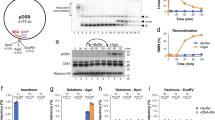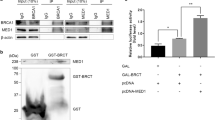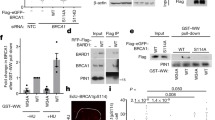Abstract
Human BRCA1 has a genetically demonstrated role in DNA repair, and has been proposed to act as a transcriptional activator in a limited number of specialized settings. To gain insight into biologically conserved functional motifs, we isolated an ortholog of BRCA1 from cattle (Bos taurus). The predicted protein product shows 72.5% sequence identity with the human protein and conservation of amino acids involved in BRCA1 structure and function. Although the bovine C-terminus is truncated by seven amino acids as compared to human, bovine BRCA1 protein exhibited a similar cell cycle-regulated nuclear expression pattern. Expression was characteristically low and diffuse in the nucleus of G1/G0 cells, followed by increasing BRCA1-positive nuclear speckles in late S phase and G2/M phase cells. Bovine BRCA1 was phosphorylated and nuclear speckling was enhanced in response to DNA-damaging agents. Consistent with evidence from studies of human BRCA1, bovine BRCA1 was shown to interact with RNA polymerase II in vivo, an activity that was mapped to the C-terminal domain (CTD) (bBRCA1364–1849). Interestingly, when tested in the GAL4 transcriptional activation assay, full-length bovine and human BRCA1 lacked any ability to act as transcriptional activators and the CTD of bovine BRCA1 had five-fold lower activity when compared to the more acidic human C-terminus. These results provide evidence that phosphorylation and nuclear relocalization are highly conserved features of the BRCA1 response to genotoxic stress. In addition, bovine BRCA1 binds the RNA polymerase II holoenzyme, but this interaction lacks significant ability to correctly orient or recruit RNA polymerase II for transcription in the classic GAL4 transcriptional activation system.
This is a preview of subscription content, access via your institution
Access options
Subscribe to this journal
Receive 50 print issues and online access
$259.00 per year
only $5.18 per issue
Buy this article
- Purchase on Springer Link
- Instant access to full article PDF
Prices may be subject to local taxes which are calculated during checkout






Similar content being viewed by others
References
Adkison L, Skow L, Thomas T, Petresh J and Womack J . (1988). Cytogenet. Cell Genet., 47, 155–159.
Altiok S, Batt D, Altiok N, Papautsky A, Downward J, Roberts TM and Avraham H . (1999). J. Biol. Chem., 274, 32274–32278.
Antoniou AC, Gayther SA, Stratton JF, Ponder BA and Easton DF . (2000). Genet. Epidemiol., 18, 173–190.
Bachelier R, Dalla Venezia N, Mazoyer S, Frappart L, Lenoir GM and Vincent A . (2000). Int. J. Cancer, 88, 519–524.
Band MR, Larson JH, Rebeiz M, Green CA, Heyen DW, Donovan J, Windish R, Steining C, Mahyuddin P, Womack JE and Lewin HA . (2000). Genome Res., 10, 1359–1368.
Barendse W, Armitage S, Womack J and Hetzel D . (1991). Cytogenet. Cell Genet., 58, 2123.
Bennett LM, Brownlee HA, Hagavik S and Wiseman RW . (1999). Mamm. Genome, 10, 19–25.
Benuck ML, Li Z and Childs G . (1999). J. Biol. Chem., 274, 25419–25425.
Berger B, Wilson DB, Wolf E, Tonchev T, Milla M and Kim PS . (1995). Proc. Natl. Acad. Sci. USA, 92, 8259–8263.
Bork P, Hofmann K, Bucher P, Neuwald AF, Altschul SF and Koonin EV . (1997). FASEB J., 11, 68–76.
Brown MA, Xu CF, Nicolai H, Griffiths B, Chambers JA, Black D and Solomon E . (1996). Oncogene, 12, 2507–2513.
Chai Y, Cui J-q, Shao N, Reddy ESP and Rao VN . (1999). Oncogene, 18, 263–268.
Chambers J and Solomon E . (1996). Genomics, 38, 305–313.
Chandler J, Hohenstein P, Swing D, Tessarollo L and Sharan S . (2001). Genesis, 29, 72–77.
Chapman MS and Verma IM . (1996). Nature, 382, 678–679.
Chen A, Kleiman FE, Manley JL, Ouchi T and Pan ZQ . (2002). J. Biol. Chem., 277, 22085–22092.
Cortez D, Wang Y, Qin J and Elledge SJ . (1999). Science, 286, 1162–1166.
Cox D and Burmeister M . (1990). Science, 250, 245–250.
Fan W, Jin S, Tong T, Zhao H, Fan F, Antinore MJ, Rajasekaran B, Wu M and Zhan Q . (2002). J. Biol. Chem., 277, 8061–8067.
Fan S, Wang J, Yuan R, Ma Y, Meng Q, Erdos MR, Pestell RG, Yuan F, Auborn KJ, Goldberg ID and Rosen EM . (1999). Science, 284, 1354–1356.
Featherstone M . (2002). Curr. Opin. Genet. Dev., 12, 149–155.
Friedman LS, Ostermeyer EA, Szabo CI, Dowd P, Lynch ED, Rowell SE and King MC . (1994). Nat. Genet., 8, 399–404.
Gatei M, Scott SP, Filippovitch I, Soronika N, Lavin MF, Weber B and Khanna KK . (2000). Cancer Res., 60, 3299–3304.
Gatei M, Zhou B-B, Hobson K, Scott S, Young D and Khanna KK . (2001). J. Biol. Chem., 276, 17276–17280.
Harkin DP, Bean JM, Miklos D, Song YH, Truong VB, Englert C, Christians FC, Ellisen LW, Maheswaran S, Oliner JD and Haber DA . (1999). Cell, 97, 575–586.
Hort Y, Baker E, Sutherland G, Shine J and Herzog H . (1995). Genomics, 26, 77–83.
Hu YF, Miyake T, Ye Q and Li R . (2000). J. Biol. Chem., 275, 40910–40915.
Joukov V, Chen J-J, Fox EA, Green JBA and Livingston DM . (2001). Proc. Natl. Acad. Sci. USA, 98, 12078–12083.
Lane TF, Deng C, Elson A, Lyu MS, Kozak CA and Leder P . (1995). Genes Dev., 9, 2712–2722.
Lane TF, Lin C, Brown MA, Solomon E and Leder P . (2000). Oncogene, 19, 4085–4090.
Lee J-S, Collins KM, Brown AL, Lee C-H and Chung JH . (2000). Nature, 404, 201–204.
Li H, Lee TH and Avraham H . (2002). J. Biol. Chem., 277, 20965–20973.
Ma J and Ptashne M . (1987). Cell, 51, 113–119.
Madsen O, Scally M, Douady CJ, Kao DJ, DeBry RW, Adkins R, Amrine HM, Stanhope MJ, de Jong WW and Springer MS . (2001). Nature, 409, 610–614.
Miki Y, Swensen J, Shattuck-Eidens D, Futreal PA, Harshman K, Tavtigian S, Liu Q, Cochran C, Bennett LM, Ding W, Bell R, Rosenthal J, Hussey C, Tran T, McClure M, Frye C, Hattier T, Phelps R, Haugen-Strano A, Katcher H, Yakumo K, Gholami Z, Shaffer D, Stone S, Bayer S, Wray C, Bogden R, Dayananth P, Ward J, Tonin P, Narod S, Bristow PK, Norris FH, Helvering L, Morrison P, Rosteck P, Lai M, Barrett JC, Lewis C, Neuhausen S, Cannon-Albright LA, Goldgar D, Wiseman RW, Kamb A and Skolnick MH . (1994). Science, 266, 66–71.
Mixon M, Kittrell F and Medina D . (2000). Oncogene, 19, 5237–5243.
Monteiro AN . (2000). Trends Biochem. Sci., 25, 469–474.
Monteiro ANA, August A and Hanafusa H . (1996). Proc. Natl. Acad. Sci. USA, 93, 13595–13599.
O'Brien KA, Lemke SJ, Cocke KS, Rao RN and Beckmann RP . (1999). Biochem. Biophys. Res. Commun., 260, 658–664.
Orelli B, Logsdon JM and Bishop DK . (2001). Oncogene, 20, 4433–4438.
Ouchi T, Lee SW, Ouchi M, Aaronson SA and Horvath CM . (2000). Proc. Natl. Acad. Sci. USA, 97, 5208–5213.
Pao GM, Janknecht R, Ruffner H, Hunter T and Verma IM . (2000). Proc. Natl. Acad. Sci. USA, 97, 1020–1025.
Perrin-Vidoz L, Sinilnikova OM, Stoppa-Lyonnet D, Lenoir GM and Mazoyer S . (2002). Hum. Mol. Genet., 11, 2805–2814.
Ruffner H, Jiang W, Craig AG, Hunter T and Verma IM . (1999). Mol. Cell. Biol., 19, 4843–4854.
Ruffner H, Joazeiro CA, Hemmati D, Hunter T and Verma IM . (2001). Proc. Natl. Acad. Sci. USA, 98, 5134–5139.
Scully R, Anderson SF, Chao DM, Ye L, Young RA, Livingston DM and Parvin JD . (1997a). Proc. Natl. Acad. Sci. USA, 94, 5605–5610.
Scully R, Chen J, Ochs RL, Keegan K, Hoekstra M, Feunteun J and Livingston DM . (1997b). Cell, 90, 425–435.
Scully R, Chen J, Plug A, Xiao Y, Weaver D, Feunteun J, Ashley T and Livingston DM . (1997c). Cell, 88, 265–275.
Scully R and Livingston DM . (2000). Nature, 408, 429–432.
Somasundaram K, Zhang H, Zeng Y-X, Houvras Y, Peng Y, Wu GS, Licht JD, Weber BL and El-Deiry WS . (1997). Nature, 389, 187–190.
Szabo CI, Wagner LA, Francisco LV, Roach JC, Argonza R, King MC and Ostrander EA . (1996). Hum. Mol. Genet., 5, 1289–1298.
Tibbetts RS, Cortez D, Brumbaugh KM, Scully R, Livingston DM, Elledge SJ and Abraham RT . (2000). Genes Dev., 14, 2989–3002.
Williams RS, Green R and Glover JNM . (2001). Nat. Struct. Biol., 8, 838–842.
Williamson EA, Dadmanesh F and Koeffler HP . (2002). Oncogene, 21, 3199–3206.
Xu X, Wagner K-U, Larson D, Weaver Z, Li C, Ried T, Hennighausen L, Wynshaw-Boris A and Deng C-X . (1999). Nat. Genet., 22, 37–43.
Yang Y-P and Womack JE . (1998). Genome Res., 8, 731–736.
Yarden RI and Brody L . (1999). Proc. Natl. Acad. Sci. USA, 96, 4983–4988.
Yu X, Wu LC, Bowcock AM, Aronheim A and Baer R . (1998). J. Biol. Chem., 273, 25388–25665.
Acknowledgements
We thank Dr Alfonso Luque and Dr Luisa Iruela-Arispe (Molecular Biology Institute, UCLA) for assistance with antisera production, and Maria del Carmen Plaza for growth of cell lines in the early stages of this work. We are grateful to Kristina Johnson and Dr Michael Carey (Department of Biological Chemistry, UCLA) for reagents and helpful discussions about RNA polymerase II, and to Dr Alvaro Monteiro (Rockefeller University, NY, USA) for plasmids and discussions related to mammalian GAL4 transcrip-tion assays. We thank Jan Johnson for screening the bovine hybrid panels and Srinivas Kata (Texas A&M) for computer analysis of the radiation hybrid results. We also thank Amilcar Rizzo and Robert Lurvey for assistance in the production of GST fusion proteins, and the other members of the Lane lab for helpful discussions.The authors acknowledge support from an NRSA pre-doctoral fellow-ship (GM07185) to SAK, and support from the Ovarian Cancer Research Fund, the Stein-Oppenheimer Foundation, the Jennifer Jones Simon Foundation, the Cancer Research Coordinating Committee of the University of California, the Stop Cancer Foundation, and funding from the Department of Defense, Ovarian Cancer Initiative (OC98-0006) to TFL.
Author information
Authors and Affiliations
Corresponding author
Rights and permissions
About this article
Cite this article
Krum, S., Womack, J. & Lane, T. Bovine BRCA1 shows classic responses to genotoxic stress but low in vitro transcriptional activation activity. Oncogene 22, 6032–6044 (2003). https://doi.org/10.1038/sj.onc.1206515
Received:
Revised:
Accepted:
Published:
Issue Date:
DOI: https://doi.org/10.1038/sj.onc.1206515
Keywords
This article is cited by
-
Profiling of Bovine Breast Cancer 1, Early Onset (BRCA1) Gene Among Frieswal (HF × Sahiwal) Cows and Their Association with Mastitis
National Academy Science Letters (2014)
-
BRCA1: a new candidate gene for bovine mastitis and its association analysis between single nucleotide polymorphisms and milk somatic cell score
Molecular Biology Reports (2012)
-
Evolutionary conservation analysis increases the colocalization of predicted exonic splicing enhancers in the BRCA1gene with missense sequence changes and in-frame deletions, but not polymorphisms
Breast Cancer Research (2005)



